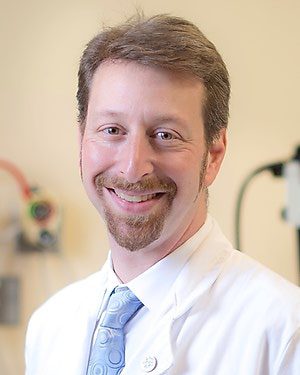The U.S. Food and Drug Administration (FDA) approved Dupixent for the treatment of moderate-to-severe atopic dermatitis in patients aged 6 months+; the drug is also approved as add-on maintenance therapy for patients aged 6 years+ with moderate-to-severe asthma and as an add-on maintenance treatment for adults with chronic rhinosinisitis with nasal polyposis. But researchers wondered whether Dupixent could be used for other indications such as eosinophilic esophagitis (EoE).
About 160,000 people within the United States alone live with EoE but, until recently, there were no approved therapeutic options for these individuals. That is, until Dupixent was approved in May 2022.
Recently, I sat down with Dr. Evan Dellon, MD, MPH, who was a lead investigator for the EoE clinical trial which led to Dupixent’s eventual approval. During our interview, we discussed what EoE is, the roles and responsibilities of being a lead investigator, Dupixent (and patient reactions), and what the future of research in this field might look like.
About Dr. Dellon
Dr. Evan Dellon, MD, MPH received his undergraduate degree from Brown University before receiving his medical degree from the Johns Hopkins School of Medicine. He has also received his Masters of Public Health in Epidemiology from the UNC School of Public Health.
Now, Dr. Dellon holds a variety of different roles at the University of North Carolina at Chapel Hill. He is an adult gastroenterologist, a Professor of Medicine, an Adjunct Professor of Epidemiology, Director of the CGIBD Biostatistics and Clinical Research Core, and Director for the Center of Esophageal Diseases and Swallowing within the University of North Carolina School of Medicine.

He shares that his clinical focuses are eosinophilic esophagitis (EoE) and eosinophilic gastrointestinal disorders (EGIDs). Dr. Dellon focuses on research to help improve the lives of patients and to provide them with better care from the diagnostic phase through treatment and management. He explains:
I spend about two-thirds of my time doing research endeavors, and EoE has long been a focus of mine, coming up on around fifteen to eighteen years.
Learn more about Dr. Dellon here.
Why Study EoE and EGIDs?
When Dr. Dellon was early in his training, including during medical school and residency, he had never really heard of eosinophilic esophagitis or EGIDs. However, while working on-call overnight shifts as a GI fellow, he began seeing how many patients would come in with food impactions and other issues. He shares:
It was surprising to me how frequently people with EoE would come in for help. I began looking into it more, but was kind of surprised to see how little was known about it at the time. There was so little information that it was difficult to understand how to make a diagnosis. If you wanted to do a research project, there were no criteria at the time to even define the disease.
Fascinated by this condition, and ready to contribute to meaningful and actionable change, Dr. Dellon decided to focus his clinical interests on EoE. He says:
I was lucky enough to begin collaborating with others within this field. Since then, there has been so much growth in knowledge, care, and even patient opportunities for research and involvement.
Eosinophilic Esophagitis (EoE): An Overview
Eosinophilic esophagitis (EoE) is a chronic allergy or immune-mediated condition which affects the esophagus. It is characterized by large amounts of eosinophils (a type of white blood cell) in the esophagus. Normally, no eosinophils are present in the esophagus. Eosinophils typically help fight infections but when present in the esophagus, they can cause inflammation and other issues. Doctors hypothesize that EoE may result from immune hypersensitivity to environmental allergens or foods, though some also hypothesize that there is a genetic or biological component as well.
Many individuals with EoE show an improvement in symptoms if they modify their diet, such as removing fish, nuts, wheat, soy, eggs, or dairy. For others with more serious symptoms, Dupixent, steroid medications, or feeding tubes with liquid formula may be required.
Eosinophilic Esophagitis Symptoms
There are a number of symptoms and characteristics associated with eosinophilic esophagitis. However, one of the complexities relating to treatment, Dr. Dellon explains, is that:
Symptoms can change over time between childhood, late childhood, and adulthood. Other symptoms are nonspecific. Younger children might present with growth troubles, feeding troubles, or difficulty advancing to solid foods. School-age children or older individuals, on the other hand, may experience heartburn, chest and abdominal pain, or vomiting. Adolescents and adults mostly have trouble with swallowing or food sticking. The problem is that there are no symptoms you can look at and say, ‘Okay, this is 100% EoE.’
One of the reasons why symptoms may change over time is due to the presence of esophageal scarring.
Dr. Dellon explains that dysphagia is one of the more common symptoms, but that sometimes people don’t really pay attention to how serious it can be. He shares:
Sometimes this presents subtly, so people adjust to the feeling over time or make some small changes to try and avoid the discomfort. They may chew more thoroughly or avoid meat, overcooked foods, rice, or crusty bread because that’s when they experience food sticking. I want to emphasize that people who are having dysphagia episodes should really talk to their doctor. It isn’t normal and needs to be checked out.
Food impaction, on the other hand, is often what brings people to the doctors or to the emergency room. Dr. Dellon explains that the choking sensation from food impaction can sometimes be misinterpreted as an acute allergic reaction or swallowing down the wrong pipe. When patients visit the emergency room for food that is stuck and won’t go up or down to try to get this figured out, this is often when they undergo an endoscopy. Of course, endoscopies may also be used as diagnostic tools outside of the emergency room setting.
Diagnostic Criteria
So how difficult is it to reach an EoE diagnosis? According to Dr. Dellon, it can be tricky; there’s typically a big delay in diagnosis of around 2-3 years following symptoms in children, and up to 5-10 years in adults. He shares:
There are a few reasons for diagnostic delays. The first is that ‘difficulty swallowing’ is not always recognized by patients as a symptom. The food sticking may be pretty intermittent and people may think that they’ve just taken too large of a bite and need to be more careful. Others may see family members having trouble so they think it’s normal.
And for little kids, they may unconsciously adapt—not liking certain foods, eating slower, not finishing meals. The next is that the symptoms themselves are important in whether they alert doctors to what is going on. If someone says they’re having trouble swallowing, there’s a pretty rapid route to check that out and make a diagnosis. But if someone has abdominal pain or heartburn, the first thing a doctor thinks is most likely not EoE because many more common conditions can cause these symptoms.
Endoscopies with biopsies are a crucial tool in making an EoE diagnosis. While a patient is asleep, a camera with a light is placed down the esophagus to look for changes like inflammation or and scar tissue. During this procedure the stomach and the first part of the small bowel are also examined. To try to diagnosis EoE, doctors take biopsies (small 1-2mm pieces of the lining of the esophagus) to be examined by pathologists under the microscope. More than 15 eosinophils in the biopsy is suggestive of an EoE diagnosis. However, doctors must also determine that there are no other health issues which could lead to the presence of eosinophils in the esophagus before confirming an EoE diagnosis.
Join us in Part 2 of our interview, where we discuss research advances, Dupixent, and the future of research within this realm.








